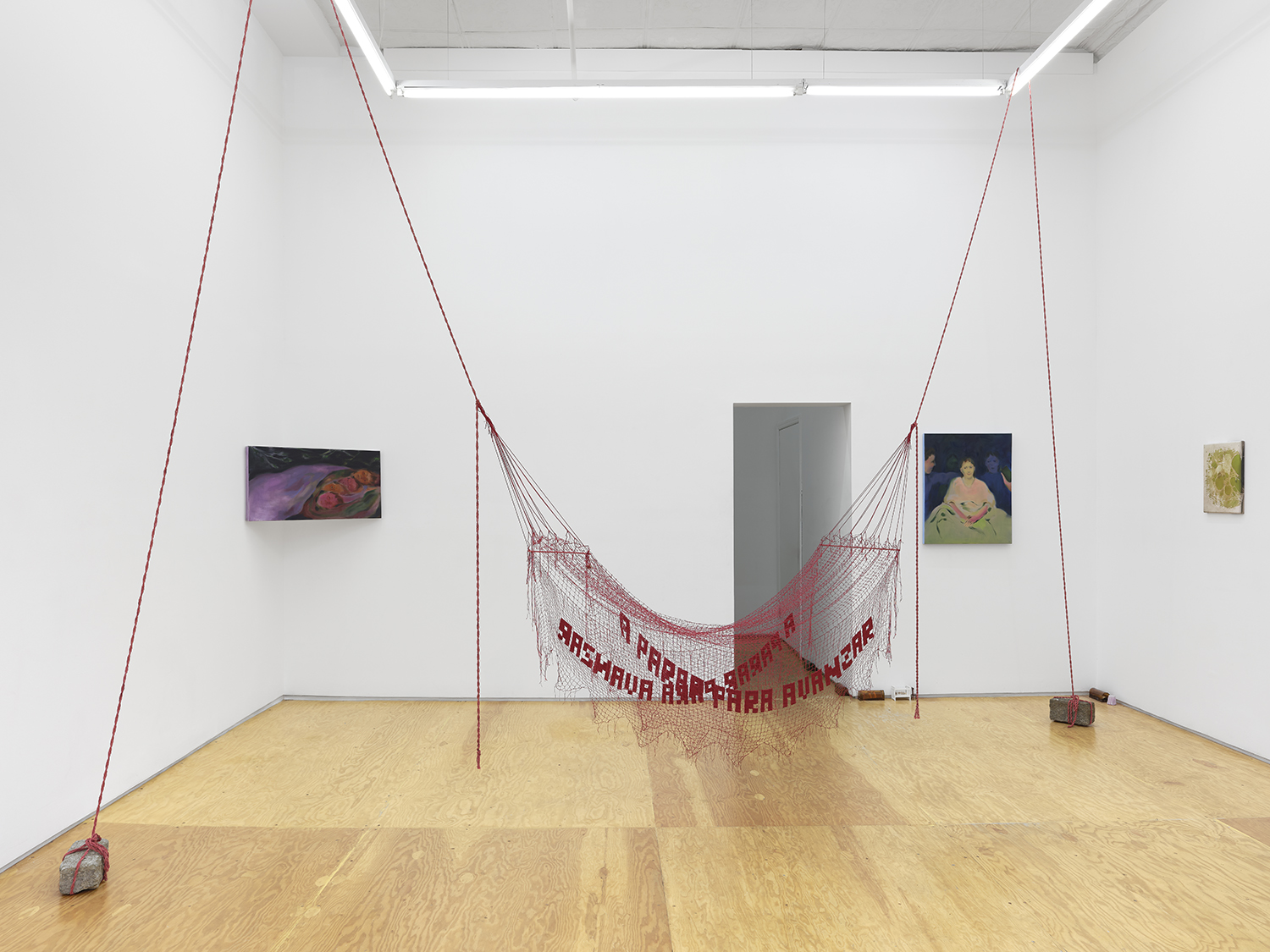


A Parar Para Avanzar
[To Stop to Advance or To Strike to Advance]
cotton-linen string, hand-dyed cotton mason line, wire, wood, cobblestones from Tribeca
228" x 36" x 168" (height variable)
2022
“The chinchorro (hammock) is an imaginative space — it is a structure for rest and leisure that, here, never fulfills its use-value. Much like the most recent Colombian uprisings from which the language “A Parar Para Avanzar” derives, the chinchorro never becomes fully materialized.
This chinchorro is slowly wrought out of respect for my body—hand-knotted over many months and later emblazoned with its message through letters handwoven into the knotted grid by needlepoint. It’s held aloft, almost at the right height to climb in, by two hand-twisted ropes and tethered to the ground with two of the large square cobblestones that pave the streets of Tribeca. It alludes to the danger of resting under a precarious wage system in its resemblance to a net or trap. Materially it cannot support you because it is not fully substantiated—the fabric is a delicate net incapable of holding even the smallest amount of weight. It does, however, invite you to imagine a reality where stopping to rest, or stopping as a tactic, really could be possible. “A Parar Para Avanzar” is a call to action that plays on the many meanings of the words.
Parar means to stop. It also means “to stand” and in the context of labor it means “to strike.” To say “a parar” makes it a command or call to action—to any of those actions. The noun “strike,” as in a labor strike, is “un paro” and the “paro nacional,” or the national strike, is an idea that is always ready at the lips of the working class Colombian (by far the vast majority of the population). The national strike as a concept has an almost mythic quality in Colombia; it is a topic of conversation that is ready at hand at any time of high dissatisfaction with the government (often) and it is a very real threat that the people wield. And yet, while there is a strong legacy of civil unrest and large popular manifestations—from the Rebelión of the Comuneros in 1781, the Mobilization of the Bananeros in 1928, and the Civic Strike of 1977—the national strike which will finally make fundamental gains is so elusive. Also, the state is so violently oppressive towards its people, that despite how within reach a strike can be in Colombia, the national strike is very much in the realm of the imagination.”
From “A Para Para Avanzar: To Stop/ToStand/To Strike to Advance”
image credit (top two images): Matthew Sherman
[To Stop to Advance or To Strike to Advance]
cotton-linen string, hand-dyed cotton mason line, wire, wood, cobblestones from Tribeca
228" x 36" x 168" (height variable)
2022
“The chinchorro (hammock) is an imaginative space — it is a structure for rest and leisure that, here, never fulfills its use-value. Much like the most recent Colombian uprisings from which the language “A Parar Para Avanzar” derives, the chinchorro never becomes fully materialized.
This chinchorro is slowly wrought out of respect for my body—hand-knotted over many months and later emblazoned with its message through letters handwoven into the knotted grid by needlepoint. It’s held aloft, almost at the right height to climb in, by two hand-twisted ropes and tethered to the ground with two of the large square cobblestones that pave the streets of Tribeca. It alludes to the danger of resting under a precarious wage system in its resemblance to a net or trap. Materially it cannot support you because it is not fully substantiated—the fabric is a delicate net incapable of holding even the smallest amount of weight. It does, however, invite you to imagine a reality where stopping to rest, or stopping as a tactic, really could be possible. “A Parar Para Avanzar” is a call to action that plays on the many meanings of the words.
Parar means to stop. It also means “to stand” and in the context of labor it means “to strike.” To say “a parar” makes it a command or call to action—to any of those actions. The noun “strike,” as in a labor strike, is “un paro” and the “paro nacional,” or the national strike, is an idea that is always ready at the lips of the working class Colombian (by far the vast majority of the population). The national strike as a concept has an almost mythic quality in Colombia; it is a topic of conversation that is ready at hand at any time of high dissatisfaction with the government (often) and it is a very real threat that the people wield. And yet, while there is a strong legacy of civil unrest and large popular manifestations—from the Rebelión of the Comuneros in 1781, the Mobilization of the Bananeros in 1928, and the Civic Strike of 1977—the national strike which will finally make fundamental gains is so elusive. Also, the state is so violently oppressive towards its people, that despite how within reach a strike can be in Colombia, the national strike is very much in the realm of the imagination.”
From “A Para Para Avanzar: To Stop/ToStand/To Strike to Advance”
image credit (top two images): Matthew Sherman
